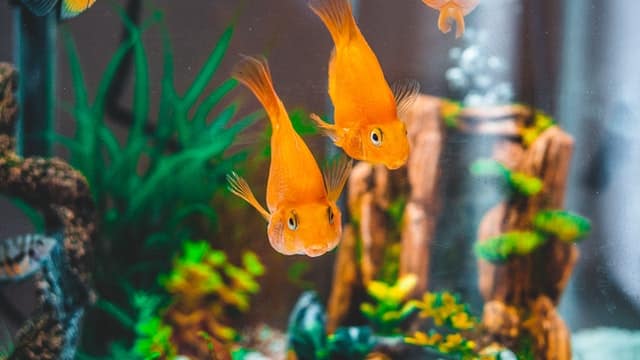The answer is yes, goldfish do need a filter. Due to the fact that they consume a lot of food and don’t really have stomachs to store that food, goldfish tend to leave behind tons of waste. Left unfiltered, a waste-filled tank will poison your goldfish.
The accumulation of such waste in a fish tank without means of disposal will quickly turn it into a swamp, which as a result, will stunt the lifespan of the goldfish significantly and won’t permit it to reach its full potential.
That’s why you should always use a filter for your goldfish.

Water Quality Needed
Did you know that a healthy goldfish lives an average of 15 to 20 years? This might come as a surprise to a lot of readers since you’re probably used to seeing goldfish say farewell after just 2 or 3 years of existing in your small fishbowl.
The lifespan of even the most well-cared-for goldfish is dependent on the quality of water they live in. This is why a fish tank that doesn’t have means of filtration will always be an unhealthy habitation space for goldfish and countless other types of fish.
So does that mean that you have to buy a fish tank for your goldfish, rather than a fishbowl? No. there are various types of water filters that are suited for both tanks and bowls. Just make sure that the fishbowl is large enough. The smaller the space the greater the need for filtration.
Types of Filters
Filters are divided into two categories: internal and external. Not to state the obvious, but as the name suggests, internal filtration systems are positioned inside the fish tank, while external models sit outside of the tank.
Which type is ideal for goldfish? Either one should do just fine. There isn’t really a correct type that must be used. But note that external filters are usually more expensive than internal ones and we’d highly recommend them if you’re not running on a tight budget.
External filters tend to have much bigger chambers than internal models, which allows them to accommodate more filtration media. Additionally, external filters usually house more powerful motors that are able to generate greater flow rates than internal models.
External filters don’t require as much cleaning as their internal counterparts and they can easily be hidden away in a cabinet so that they don’t mess with the aesthetics of your fish tank. Also, given that they’re located outside of the fish tank, they leave more space for the fish to swim in.
Luckily, both internal and external filters are available in every size you’d imagine and have a wide range of flow rates, which is the amount of water they can filter per hour. Depending on the size of your fish tank, your choice of filter will change.
Ideally, you want a filter that is close to 10 times the volume of your fish tank. So for a 15-gallon fish tank, a filtration system that features a flow rate of around 150 gallons per house should be what you’re aiming to buy.
For small fishbowls and tanks that don’t have enough room for an external filter to hang on, we’d recommend going for internal models instead. But like we’ve mentioned, you should always opt to keep your fish in a fairly large tank to maximize their potential. This will also allow you to use an external filter, rather than an internal one
How Does a Filter Work?
The idea behind a filter is pretty simple. Basically, a filter draws water out of the tank using a pump and then pulls the water through the filtration media. There are various types of media, including biological, mechanical, and chemical media.
All three types of media are highly recommended, but a quality filtration system requires at least mechanical and biological media. The components of each media type can be used in the same filter simultaneously. The exact materials vary from one filter to another.
The purpose of a filter is to purify the water from contaminants that can harm goldfish or other species of fish. Such pollutants include excrement, chlorine, heavy metals, etc. Filters also allow for beneficial bacteria to help get rid of organic waste by strapping it in the filtration media.
Without a proper filtration system, the contaminants in the water can cause fungal and bacterial infections to the fish. Also, these pollutants can reduce the amount of oxygen in the water, which may lead the fish to suffocate since they rely heavily on oxygen for breathing just like us.
For people who are unable to afford a filter, there are a few things you can do. Firstly, regular water changes are a must. Ideally, twice a week. Further, whenever the water starts looking dirty or cloudy, a water change is needed immediately.
Other signs that indicate the need for water change is your goldfish constantly gulping for air at the surface of the water. This means that the water is completely depleted of oxygen. It also helps to keep the fish tank away from sunlight, as it vitalizes the growth of bacteria and algae.
Another thing you can do regenerate oxygen in the water is to add live plants. We all know that plants absorb the carbon dioxide in the air and release oxygen constantly. This same process can also take place underwater.
Conclusion
Do goldfish need a filter? Absolutely! Just keep in mind that not any old filter will do. You need a filter that has a great capacity and high flow rate so that it can handle the volume of your fish tank. And like we’ve mentioned, you should aim to buy a filter that can turn over around 10x of the tank’s volume per hour.
We know that goldfish look pretty nice in fishbowls, but smaller fishbowls won’t allow the fish to live up to its estimated lifespan. So do your aquarium buddies a favor and get them a larger fish tank with enough room for them to breath. Also, make sure to remove excess food so that it doesn’t rot and contaminate the water.
